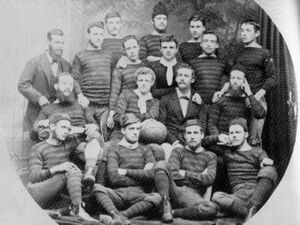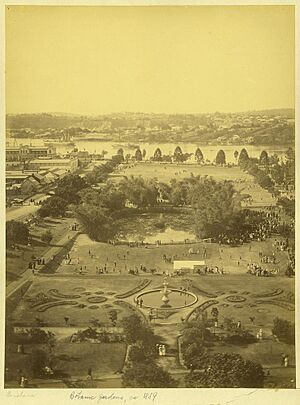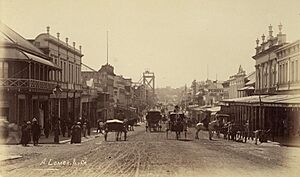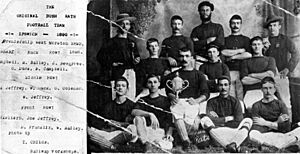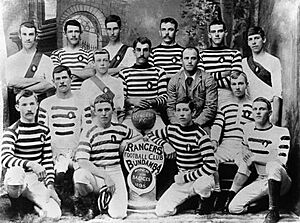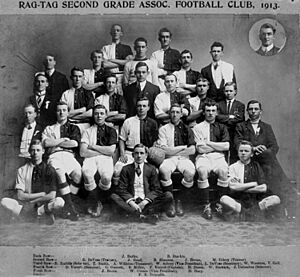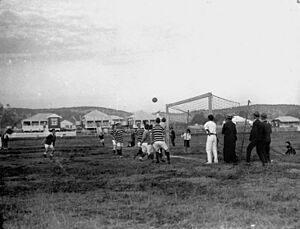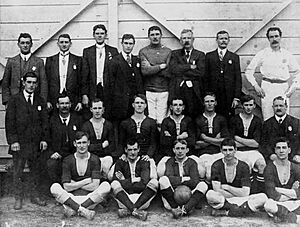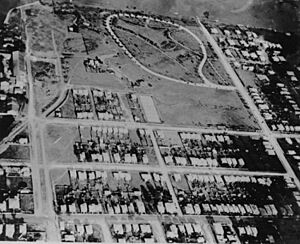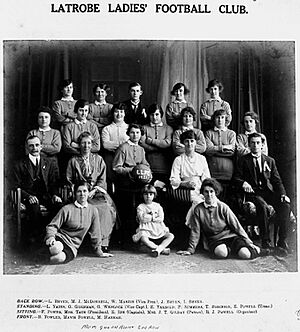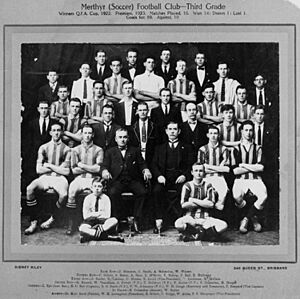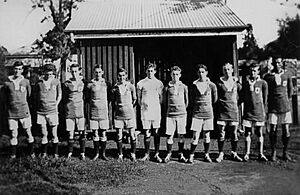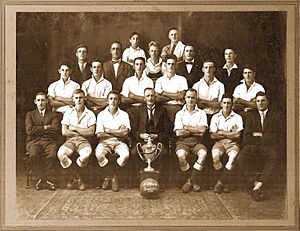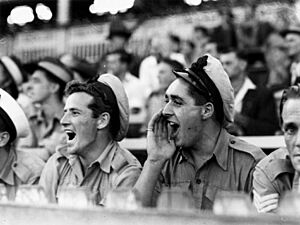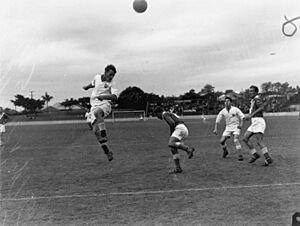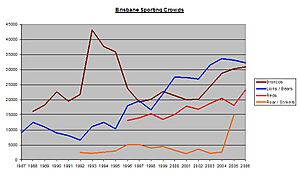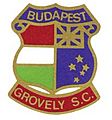History of soccer in Brisbane, Queensland facts for kids
The game of soccer has a long history in Brisbane, Australia. Records show that regular games started in the early 1880s. Scottish immigrants were among the first to play in places like Queen's Park and Melbourne Street. In 1884, they formed the Anglo-Queensland Football Association. They played matches at the Pineapple Hotel sports field in Kangaroo Point and Queen's Park.
However, soccer faced challenges because Rugby Union was already very popular in Brisbane. Later, rugby league also became very big from the 1920s. Soccer also had problems with clubs disagreeing, especially with teams from nearby Ipswich. Ipswich teams were very strong and often won against Brisbane teams until about 1960.
After World War II, many European and British immigrants arrived. They loved soccer and formed their own clubs, which became very successful in the 1960s and 1970s. This also led some people to think of soccer as mainly a "migrants' game."
From the 1980s onwards, more and more people, both boys and girls, started playing soccer. However, it didn't become as popular at a professional level as the other football codes. The Brisbane Roar FC joined the national A-League in 2005. They won championships in 2011, 2012, and 2014, and premierships in 2010-11 and 2013–14. Despite their success, they still haven't become as popular as Brisbane's rugby teams.
Contents
- Early Days: First Football Games in Brisbane
- 1880s: Regular Soccer Games Begin
- 1890s: Ipswich Teams Take Over
- 1900s: Brisbane Soccer Struggles
- World War I Years
- 1920s: Soccer Grows, Then Struggles
- 1930s: A Decade of Disagreements
- World War II Years: Professionalism Appears
- Post-War to 1960s: Paid Players and Ethnic Clubs
- 1970s: National Soccer League Begins
- 1980s: Brisbane Competition Changes
- 1990s: Brisbane Strikers Win NSL
- 2000s: A-League Begins
- Honours
- Brisbane's Oldest Existing Clubs
- Images for kids
Early Days: First Football Games in Brisbane
Football was played in Brisbane very early on. A newspaper notice from 1849, just 25 years after the first European settlers arrived, invited people to a game of "Foot Ball" at Kangaroo Point. At that time, Brisbane had only about 2,000 people.
The type of football played back then might have been mob football, which was a very rough game. Or it could have been played under early rules like the Rugby school rules (1845) or the Cambridge rules (1848). The Cambridge rules were an early version of what became the laws of soccer.
First Football Clubs in Brisbane
Organized football games were happening in Brisbane by the mid-1860s. The Brisbane Courier reported on a "very lively game" in 1866. This likely referred to the Brisbane Australian Football Club, formed in 1866, playing Melbourne rules (now called Australian rules football). The games were probably played at Queen's Park (now part of the City Botanic Gardens).
The first known mention of a soccer club in Brisbane was the Petrie Terrace Football Club in 1876. They first planned to use the "London Association rules" (soccer rules). But a week later, they decided to use the rugby union rules instead. Other Brisbane clubs, like the Rangers Football Club (formed 1876), also played both Melbourne rules and rugby rules.
First Games Under Soccer Rules
It seems the Brisbane Football Club played at least one game of soccer. In August 1875, they played against people from the Woogaroo Lunatic Asylum (near Goodna). A rule for this game was "the ball should not be handled nor carried," which means it was played under soccer rules. This might be the earliest known soccer game in the Brisbane area. Regular soccer games didn't start until 1884.
The first club formed specifically to play soccer rules in Brisbane was the Rangers Football Club in 1883.
1880s: Regular Soccer Games Begin
The 1880s were a time of growth for Brisbane, with many new people arriving. Around 1883, a group of mostly Scottish immigrants started playing soccer at Queen's Park. They were sometimes called "Scotch rulers" by players of other sports. After some issues with sharing fields, they moved to vacant land in South Brisbane. Later, they got permission to play at the Pineapple Sportsground in Kangaroo Point (now part of Raymond Park).
In May 1884, a meeting was held at the Australian Hotel. People who liked the "Association" game (soccer) decided to form the Anglo-Queensland Football Association. They also created the first club, called "St. Andrew's Football Club." This group was joined by the Rangers Club and a new "Queen's Park" club. These names were likely inspired by famous Glasgow football clubs in Scotland. Scottish players were known for their clever "scientific" approach to the game.
First Official Matches
The first official soccer match of that season was played on Saturday, June 7, 1884. It was between Queen's Park and St Andrew's at the Pineapple Ground. St Andrew's won 7-0. The next week, St Andrew's played Rangers, and the game ended in a 1-1 draw. The newspaper said the play was "a great improvement." Rangers won the final game of the season against St Andrew's 1-0 and received winners’ badges.
By 1886, soccer was becoming very popular. About 400 spectators watched Queen's Park play St Andrew's, with St Andrew's winning 7-0. Other teams like Swifts (Brisbane), Bundamba Rovers, and Queenslanders (from Ipswich) also played. St Andrew's won all 10 of its matches in 1886.
The Ipswich teams could play Brisbane teams because the Ipswich railway line had opened in 1876. Many Welsh and northern English coal miners had settled in Ipswich, and they loved soccer. In 1887, the Thistle Football Club, a new group from St Andrew's, joined the competition and won the AQFA Cup final in 1888.
The Battle of the Codes
However, the Northern Rugby Union (NRU) also formed in 1884. Rugby quickly became very popular, especially after the Queensland Rugby team beat New South Wales for the first time in 1886. This success helped rugby become the main sport in Queensland. By 1887, the NRU had 25 clubs.
By the end of the 1880s, newspapers said rugby was very successful, while Australian rules football and soccer were struggling. The original soccer clubs (Queen's Park, St Andrew's, and Rangers) seemed to disappear by the early 1900s.
1890s: Ipswich Teams Take Over
The Queensland British Football Association
In 1890, the Anglo-Queensland Football Association changed its name to the Queensland British Football Association (QBFA). This was likely to recognize the many Scottish and Welsh immigrants playing the game.
First Inter-Colonial Matches
In August 1890, a Queensland team traveled to play against New South Wales. Queensland won two matches and played another in Newcastle. They scored ten goals and only lost three on this trip.
Ipswich Teams Join the Competition
In 1891, three clubs from Ipswich joined the QBFA competition. These likely included Bundamba Rangers, Blackstone Rovers, and the Bush Rats. The Bundamba Rangers won in 1895, and the Bush Rats won several championships in the late 1890s and early 1900s. This started a period where Ipswich teams were much stronger than Brisbane teams, winning many championships and producing many top players.
Ipswich's success was partly because many miners from Great Britain, where soccer was huge, settled there. Also, coal mine owners encouraged football by providing land for teams. In Ipswich, soccer didn't face as much competition from other sports as it did in Brisbane. There was also a strong rivalry with Brisbane, which had become the capital of Queensland instead of Ipswich in 1859.
Ipswich Teams Leave the Competition
By the late 1890s, the Ipswich clubs were unhappy with the QBFA. They felt they weren't treated fairly, especially since Ipswich had more strong clubs than Brisbane at the time. So, they formed their own Ipswich and West Moreton British Football Association and left the QBFA competition. This caused problems for soccer in Brisbane.
Meanwhile, rugby was very strong. In 1899, about 15,000 people watched England play Australia in rugby at the Brisbane Exhibition Ground. This was the biggest sports crowd ever seen in the colony.
1900s: Brisbane Soccer Struggles
Brisbane soccer suffered when Ipswich teams left. In 1901, the Ipswich Association suggested taking over Brisbane's cups until soccer in Brisbane got better. A newspaper reported that only two Brisbane teams entered the 1900 Challenge Cup against Ipswich teams.
The QBFA annual meeting in March 1903 had to be postponed because too few people showed up. They decided to make a "special effort" to improve the game. They also arranged to use the Botanic Gardens for playing.
Ipswich Clubs Rejoin
In 1903, the Ipswich clubs rejoined the QBFA. The Bush Rats won the senior final that year. Other teams included Eskgroves (Brisbane), Milton, Wellingtons, and Reliance (Ipswich). However, the game was still unstable, with some teams not re-entering competitions the next year.
In 1907, goal nets were used for the first time in Brisbane during a match between Milton and Dinmore. Around this time, local newspapers started calling "Association Football" by the name "soccer." This term came from Oxford University slang in the 1890s. The sport was called 'soccer' for nearly 100 years until Football Federation Australia started calling it 'football' again in 2005.
Soccer continued to struggle in this decade. In 1909, only five senior clubs were part of the association. By 1910, this increased to seven senior and nine junior clubs. Australian Rules football was also struggling in Brisbane, with Ipswich beating Brisbane 102 points to 1. In 1909, the first Brisbane Rugby League competition began, and rugby league eventually became the most popular sport in Brisbane.
By 1912, soccer was growing again. There were at least three divisions with teams like Albion, Blackstone Rovers, Bulimba Rangers, Bush Rats, Eskgrove, Pineapple Rovers, Red Rovers, Rebels, and Shafston Rovers.
In 1913, a "record number of teams" entered the competitions. The First Division included teams like Albion, Australian Meat Works, Bulimba Rangers, Corinthians, Eskgrove, Toowong, Wellington, and YMCA. The opening match was at the Brisbane Cricket Ground, with a large crowd watching Wellington beat Bulimba Rangers 1-0. The 1913 Premiership was won by Bulimba Rangers.
The only club still around from this time is Oxley United FC, founded in 1912.
World War I Years
Commonwealth Football Association
In April 1914, Brisbane hosted a meeting for the Commonwealth Football Association. They discussed sending a team to the Olympic Games in Berlin in 1916. However, this didn't happen because World War I started just two months later.
Ipswich Clubs Leave Again
Once again, the Ipswich clubs decided to leave the Brisbane competition. A letter to the editor in 1914 said it was a "pity" because Brisbane had a lot to learn from Ipswich players. However, soccer was still popular in Brisbane. Thousands of fans watched Ipswich beat Brisbane 2-1 at the Albion Flats. The Ipswich team had players from Booval, Bush Rats, Goodna, Ipswich City, Bundamba Rangers, and St Stephen's.
The 1915 season had at least fourteen teams. Merthyr Thistle won the first-grade senior competition. Junior competitions were also reported.
Competition Suspended
In early 1916, the QBFA reported that "31 clubs played... comprising over 600 registered players." However, they decided to suspend the main competitions. Players of military age were not allowed to play in lower competitions. Clubs were only allowed to play friendly matches. Despite this, club matches continued between teams like Milton, Technical College, and Natives.
In 1917, about thirty teams played in QBFA competitions across at least three divisions. St Ellena and Latrobe played in the Third Grade Premiership final, with St Ellena winning 1-0. Latrobe (now Bardon Latrobe) is the only Brisbane club from that season that has continued to exist.
By 1918, the competition had at least 22 Brisbane teams, many of them new clubs. Many clubs shared grounds, for example, at Pineapple/Raymond Park and Milton. During the war, Ipswich teams again did not play in the Brisbane competition.
In 1919, the men's competition had four grades. The semi-finals were played at the Exhibition Ground. Pineapple Rovers were the First Grade Premiers, beating Merthyr Thistle 3-1.
1920s: Soccer Grows, Then Struggles
Rugby League Becomes Dominant
The 1920s were a key decade for all football sports in Brisbane. Rugby Union had been the main sport since the 1880s. But after Rugby League started in Brisbane in 1908, and with World War I, Rugby Union declined. Many major clubs and schools switched to rugby league by 1918. The Queensland Rugby Union stopped existing in 1919 and didn't restart until 1928. By then, Rugby League had become the most popular football sport in Brisbane, and it remains so today.
The Queensland Football Association
By 1920, the QBFA was simply called the 'Queensland Football Association' (QFA). Ipswich teams had rejoined the Brisbane competition. The 1921 QFA season had eight teams in the First Grade, including Brisbane City, Bundamba, Corinthians, Bush Rats, Pineapple Rovers, South Brisbane, Thistle, and Wynnum. Ipswich teams, especially Bundamba Rangers, Bush Rats, and Blackstone Rovers, were very strong and won most of the championships in this decade.
Ladies Competition Formed
In 1921, the Queensland Ladies Soccer Football Association was formed. About 100 ladies attended the meeting. Three clubs were created: Latrobe Ladies, North Brisbane, and South Brisbane. Amazingly, about 10,000 spectators watched North Brisbane beat South Brisbane 2-0 at the Brisbane Cricket Ground in September 1921. The association wanted to start regular matches with about six teams, but there are no clear records of their progress after 1922.
Brisbane and District Football Association
In 1928, the Brisbane and District Football Association (BDFA) replaced the QFA. The league had two divisions. Bundamba Rangers won the Premiership that year.
However, some reports from the late 1920s said that soccer was struggling. This led to some groups breaking away.
Ipswich Teams Leave Again
Things got worse in 1929 when the three Ipswich clubs (Bundamba Rangers, Dinmore Bush Rats, and St Helens) left the semi-final round. They said it was because they weren't allowed to share the profits from matches. The Brisbane clubs were tired of the constant arguments with Ipswich. The Ipswich clubs were fined and suspended, and they were not part of the Brisbane competition in 1930. With Ipswich gone, Latrobe became the strongest team, winning six out of seven Premierships between 1929 and 1935.
1930s: A Decade of Disagreements
Queensland Soccer Association
The new Queensland Soccer Association (QSA) formed a First Division with eight Brisbane clubs for the 1930 season. Latrobe won the 1930 Premiership.
By 1934, the game seemed to have shrunk. The First Division had eight teams, and the Second Division had only six.
Soccer Leases Lang Park
In 1935, the Queensland Soccer Council (QSC) took over the lease of Lang Park to use it as the main ground for soccer matches. Latrobe also used the ground for its home games.
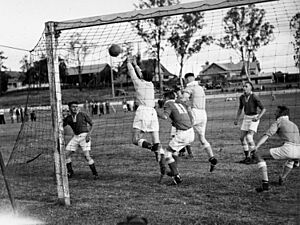
By 1937, the QSC was thinking about leasing Lang Park to another sport because they weren't making enough money. Latrobe said they would only pay more rent if the Ipswich clubs rejoined the Brisbane competition.
After many talks, the QSC decided to merge the Brisbane and Ipswich associations for the 1937 season. Ipswich and Brisbane teams played together again for the first time since 1929. Bundamba Rangers won the Premiership in 1937, 1938, and 1939.
Despite the game's apparent strength, some people felt soccer in Brisbane wasn't as strong as it had been ten years earlier. They hoped that a visit from an English amateur team would help.
Signs of Disagreement
Even with a seemingly good 1937 season, there were problems. Four club officials were suspended for discussing how soccer was managed. The secretary of the BDFA warned that "a grave crisis" could happen if disagreements continued. However, the president of the QSC claimed that soccer's popularity had grown so much that its attendance was close to rugby league's.
The only clubs from the 1930s Brisbane competitions that still exist today (or have descendants) include Bundamba and St Helens (now Ipswich Knights), Latrobe (now Bardon Latrobe), Merton Rovers (merged with Eastern Suburbs), Pineapple Rovers (now Kangaroo Point Rovers FC), Toowong (now Toowong FC), Oxley Ramblers (now Oxley United F.C.), and Wynnum (now Brisbane Wolves).
World War II Years: Professionalism Appears
For the 1940 season, there were more changes. The major Ipswich clubs initially didn't want to join the new Queensland Soccer Football Association (QSFA). However, most of them eventually did. Latrobe had "four international players," including two former Bundamba players. This suggests that Latrobe, and possibly other clubs, were paying players to join them, even though it was against the QSFA rules.
The teams for the 1940 season included Blackstone, Booval, Bundamba, Corinthians, Easts, Latrobe, Wynnum, and YMCA. Corinthians won the Premiership.
Soccer Competitions Suspended
After the 1941 season, the competition was stopped because of World War II. Only games between servicemen's teams or teams of essential workers were played. Play started again in 1944 with six teams. In 1945, four more teams joined, including two Royal Navy teams. St Helens won the Premiership that year.
Post-War to 1960s: Paid Players and Ethnic Clubs
The 1946 season started well, with 31 teams playing in Brisbane senior competitions. The First Division had ten teams, and YMCA won the Premiership.
However, problems started when the Corinthian club announced they would pay players. They wanted to challenge the ban on player payments. They argued that players should get a share of the profits. This was proven right when the New South Wales team, which had professional players, beat Queensland 10-0.
Ipswich clubs continued to dominate soccer after the war. St Helens, Dinmore Bushrats, and Bundamba Rangers won eight championships between 1946 and 1959. Four Ipswich players were even on the Australian team for the 1956 Olympics in Melbourne. However, this Ipswich dominance didn't last. Wealthy ethnic clubs in Brisbane started attracting the best Ipswich players, leading to the start of professional soccer in Queensland.
Ethnic Clubs Become Strong
After the war, the Australian Government encouraged many people from Europe to move to Australia. These immigrants from countries like Italy, Greece, Germany, and Poland loved soccer. They formed their own social clubs and soccer teams, which greatly increased the number of players and fans in Australia. In Brisbane, large ethnic groups created strong teams like Azzurri (Italian, now Brisbane City), Budapest-Grovely (Hungarian, now Westside), Germania (German, now Southside Eagles), Hellenic (Greek), and Hollandia (Dutch, now Lions FC). Latrobe (now Bardon Latrobe) was mostly made up of British and Irish players.
From 1960 to 1978, every Brisbane First Division Premiership was won by an ethnic-based club.
However, there were also disagreements within the game. There was a conflict between amateur and professional groups. FIFA, the world soccer body, even suspended Australian soccer for a while. These problems continued until 1962.
In the early 1960s, the top eight first-division clubs broke away from the Queensland Soccer Football Association and formed the new Queensland Soccer Federation (QSF). The QSF became the main soccer body in Queensland.
1970s: National Soccer League Begins
To be more welcoming and to change the idea that soccer was only a "migrants' game," the QSF ruled in 1973 that all clubs had to use non-ethnic names.
In the early 1970s, Brisbane City (formerly Azzurri) and Brisbane Lions (formerly Hollandia) were the strongest local teams.
The National Soccer League (NSL) started in 1977 with fourteen teams from different parts of Australia. Brisbane had two teams: Brisbane Lions and Brisbane City. Neither club won the championship, but Brisbane City won the NSL Cup in 1977 and 1978, and Brisbane Lions won it in 1981.
In 1979, a Queensland-wide State League competition began. Grange Thistle won the first one. This competition only lasted until 1982.
1980s: Brisbane Competition Changes
Brisbane City and Brisbane Lions continued to play in the NSL but didn't have much success. Both teams left the competition after the 1986 season. Lions rejoined in 1988 but finished last. A new team, Brisbane United, joined the NSL in 1991-92 but also had limited success.
In the early 1980s, the Mt Gravatt club (started in 1960) was very strong in the State League and Brisbane competitions. After the State League ended in 1982, the QSF changed the top level of the Brisbane men's competition to the 'Premier' division in 1983. Brisbane City, Brisbane Lions (now Lions FC), Ipswich United, and North Star shared the premierships for the rest of the decade.
1990s: Brisbane Strikers Win NSL
The Brisbane United team was renamed the Brisbane Strikers for the 1993-94 season. They played well and won the championship in the 1996/97 season. They beat Sydney United 2-0 in front of a record crowd of over 40,000 people at Lang Park in Brisbane. During this decade, Brisbane City won four Brisbane Premier League premierships, while Brisbane Lions and North Star each won two.
A big change for soccer happened in the early 1990s when it became an official sport in private schools (Great Public Schools Association of Queensland Inc.). Rugby Union in these schools strongly resisted this change. Since then, many schools now have as many soccer teams as rugby teams.
2000s: A-League Begins
In 2003, Brisbane Men's soccer changed its senior competition. It became a semi-professional 'Premier League' with three divisions and an amateur 'Metropolitan League'. Teams could move up or down divisions each season in the Premier League.
In the early 2000s, the Queensland Lions club was very strong, winning many premierships and cups from 2002 to 2004. The Lions club, as Queensland Roar FC, was chosen to join the first national A-League competition, which started in 2005-06. The club changed its name to Brisbane Roar FC in 2009. The Brisbane Roar, even with good crowds, still hasn't become as popular as the Brisbane Broncos (rugby league), Brisbane Lions (Australian rules), and the Queensland Reds (rugby union).
After the Brisbane Lions club left the local league, Palm Beach and the Brisbane Strikers were very strong for the next two seasons. Rochedale Rovers then dominated the Premiership for the rest of the decade.
Brisbane Roar won their first A-League trophy in the 2010-11 season, losing only one match. They then won the 2010-11 Championship grand final in a very exciting way. They scored twice in the last four minutes of extra time to draw 2-2 against the Central Coast Mariners, then won a penalty shootout 4-2.
Queensland State League Begins
In 2007, all the Brisbane soccer groups joined together to form Football Brisbane. The state-wide Queensland State League (QSL) started in 2008 as the second level below the A-League. Local teams like the Brisbane Strikers, Olympic FC, and Redlands Devils played in the first season. However, Redlands and Olympic left the QSL after 2009 and rejoined the Brisbane Premier League. The Strikers club has played very well in the QSL.
Soccer in Brisbane in the 2000s still had some disagreements between clubs and the soccer associations about how competitions should be set up and how money should be used.
Honours
Most First Grade Premierships
(Up to and including season 2016)
| Rank | Team | Number of Premierships |
|---|---|---|
| 1 | Hollandia-Inala/Brisbane Lions/Queensland Lions | 14 |
| 2 | Dinmore Bush Rats (linked to Ipswich Knights) | 11 |
| 3 | Latrobe (now Bardon Latrobe) | 9 |
| 4= | Azzurri (now Brisbane City) Bundamba Rangers (linked to Ipswich Knights) Hellenic/St George-Souths (no longer exists) |
8 |
| 7= | Blackstone Rovers (linked to Ipswich Knights) Corinthians (no longer exists) |
5 |
Brisbane's Oldest Existing Clubs
Oldest Club
The oldest club that has continuously existed seems to be Oxley United FC (formerly Oxley Soccer Club and Oxley Ramblers). Club records show it was started in 1912 or 1913. Oxley first appeared in Brisbane news reports in 1918. The club reached its peak in the late 1950s, winning the First Division premiership. The club now plays at Dunlop Park, Corinda.
Other Old Clubs
- Kangaroo Point Rovers: This club has links to the Pineapple Rovers club, which may have started in 1886. Pineapple Rovers played at Raymond Park, Kangaroo Point for many years.
- Grange Thistle SC: This club has indirect links to St Andrew's, one of the first soccer teams from 1884. A "Thistle" club formed in 1887, and later became Merthyr Thistle. A group from Merthyr Thistle formed the current Thistle club (now Grange Thistle) in 1919.
- Ipswich Knights: This club was formed from several mergers of older Ipswich clubs. Dinmore Bush Rats (1888) merged with Redbank in the 1950s. This club then merged with St Helens (formed 1912) in the 1960s. St Helens then merged with Coalstars (which was a merger of Blackstone Rovers and Bundamba Rangers) in 1998 to form the Ipswich Knights.
- Toowong FC: A Toowong club was mentioned as early as 1911. The first results for a Toowong 'soccer' club were in 1913. Toowong clubs have stopped and restarted a few times over the years.
- Redlands (1918), Mitchelton (1920), and Easts (1922): These clubs state these founding dates, but public records for them appear a few years later.
The oldest club that has played continuously in Brisbane senior men's competitions is Wynnum, which entered the Brisbane First Division in 1921, the year it was formed. The club is now called Wolves FC.
The oldest club that has played continuously in Brisbane competitions is Bardon Latrobe. The Latrobe club first appeared in news reports in 1917. After several mergers and de-mergers, the club rejoined senior football in 2011.
The oldest club that is still in its original form and using its original name, and has played continuously in the Brisbane senior competitions, is Taringa Rovers, formed in 1949.
Images for kids


